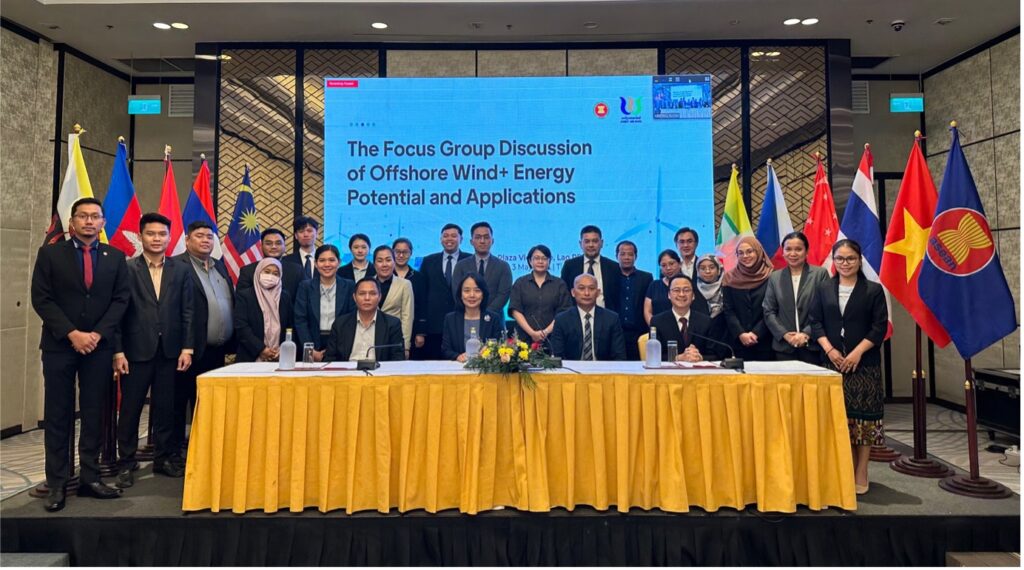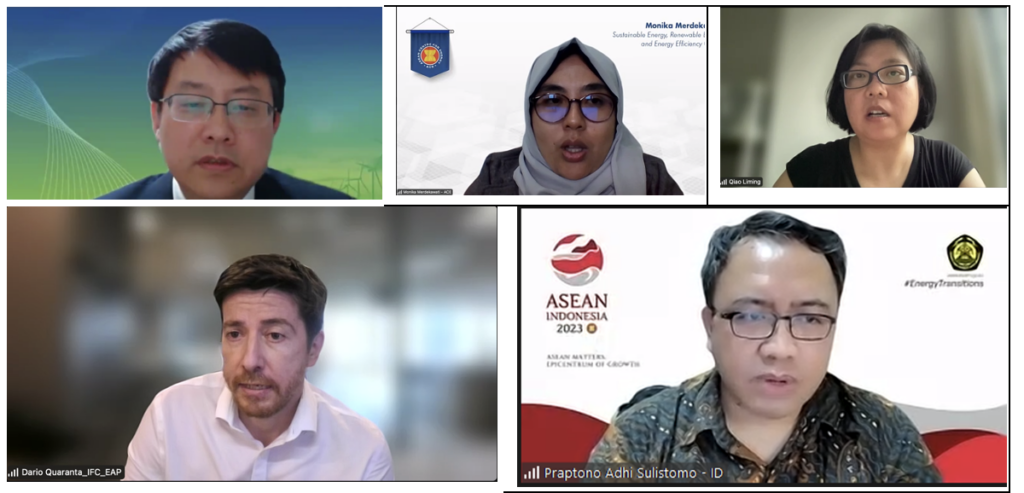Menu

Photo 1. Photo session of all onsite participants and distinguished speakers of the Workshop on Offshore Wind+ Energy Potential and Applications in ASEAN
On 3 May 2023, the ASEAN Centre for Energy (ACE), alongside with ASEAN Secretariat, Lao PDR’s Ministry of Energy and Mines, and China Renewable Energy Engineering Institute (CREEI) co-organised a hybrid workshop of Offshore Wind+ Energy Potential and Applications in ASEAN. The event was part of the 30th Annual Meeting of the Renewable Energy Sub-Sector Network (RE-SSN) of the ASEAN Energy Cooperation Associated Meetings in Crowne Plaza Vientiane, Lao PDR from 2 – 5 May 2023.
The workshop was aimed to showcase the offshore wind potential in ASEAN and to explore the development priorities of the technology for each ASEAN country. It was attended by government officials, public utility representatives from each ASEAN member state (AMS), and World Bank as the foremost financial institution. Introduction to offshore wind+, or hybrid application of the technology with other energy sources or industries, and grid management for the project were also given by case studies from well-respected speakers from China, Indonesia, Thailand, and the Philippines. The workshop has been deemed a success through its fruitful discussion it became.

Photo 2. Distinguished speakers for the Workshop of Offshore Wind+ Energy Potential and Applications in ASEAN that joined online. From the top left to bottom right, Dr Gu Hongbin, Ms Monika Merdekawati, Ms Liming Qiao, Mr Dario Quaranta, and Mr Praptono Adhi Sulistomo
The workshop was opened by remarks from the Deputy Director General of the Department of Energy Efficiency and Promotion, Lao PDR’s Ministry of Energy and Mines, Mr Khammanh Sopraseurth, Senior Manager of ACE, Mr Christopher G Zamora, and Deputy Director General of CREEI, Dr Gu Hongbin. In their remarks, they pointed out that only fractions of wind potential are currently being explored in ASEAN, with data from 2020 showing the number of installed wind capacity in that year only accounted for 2.7 GW, despite the overwhelming 1,000 GW wind potential capacity.
There are three main topics discussed in this workshop. The first topic was the ASEAN Offshore Wind development prospect, which was moderated by Ms Ngoc Huong Giang Vu, Associate Research Analyst of ACE. Meanwhile, the second and last topics were about innovative applications and high-proportion grid solutions of offshore wind+, respectively.
As the opening on the first main topic, Ms Monika Merdekawati, Sustainable and Renewable Energy (SRE) Department Research Analyst of ACE, shared the study findings from the A-Wind Offshore+ project, which is the continuation of the A-Wind project launched in the 5th East Asia Summit 2021. She found that several new sites for offshore wind development in three ASEAN countries are identified in addition to the wind potential data shared by the World Bank – ESMAP.
The study discusses the technical aspect of the development and points out related policies and strategic stakeholders which regulate, operate, and maintain the offshore wind industries. In which, Ms Liming Qiao from the Global Wind Energy Council (GWEC) agreed with the same point made by Ms Monika Merdekawati, which pointed out that unstable policy frameworks and no clear route to deploy the technology are what hinder the application of offshore wind in ASEAN. Currently, permits for offshore wind deployment are still solely based on the application of onshore wind, despite many differences between them.
There were two other highly respected speakers in the first session. Ms Muzi Zhang, Director of the General Affair Division, International Cooperation Department of CREEI, shared the offshore wind development experience in China and condition similarity between ASEAN and China in terms of its resource conditions, geographical climates, and development background, which she believes will help ASEAN in finding its way towards more advance development of offshore wind in the coming future.
Lastly, the first main session was closed by Mr Dario Quaranta, Senior Operations Officer in the Philippines, International Finance Cooperation of World Bank. He mentioned that the World Bank Group is currently providing technical assistance for offshore wind in the two most potential countries for the technology, Vietnam and the Philippines. He added that no regional collaboration on the supply chain halted the investment opportunity for many ongoing offshore wind projects in ASEAN.
Next, Mr I Dewa Made Raditya Margenta, Research Analyst of ACE, moderated the second main session with three subtopics discussed. These subtopics were brought by Ms Xueqian Yang, Project Coordinator, International Cooperation Department of CREEI, Mr Praptono Adhi Sulistomo, Directorate of Various New Energy and Renewable Energy, Ministry of Energy and Mineral Resources Indonesia, and Ms Clarita S. De Jesus, Senior Science Research Specialist Department of Energy, Philippines. In Ms Xueqian Yang’s session, she showcased some technical innovations for offshore wind development in China and offshore wind+ application with the fish farm in Laizhou, and with an offshore oil and gas field in CNOOC Guanlan, which can produce electricity of 22 GWh and 7.73 million m3 fuel gas annually. Meanwhile, in Mr Praptono Adhi Sulistomo and Ms Clarita S. De Jesus’s sessions, they both showcased the development of floating solar PV platforms in Indonesia and offshore wind projects in the Philippines, respectively. To date, a total of 63 offshore wind projects have been awarded in the Philippines, with an approximate potential aggregate capacity of 49.9 GW.
Progressing onto the next session, Ms Yicheng Wang, Project Coordinator of International Cooperation Department of CREEI, led the last discussion session. Dr Geng Dazhou, Specialist, New Energy Department of CREEI opened the discussion by sharing China’s experience in offshore wind power transmission strategies and laying out several recommendations for offshore power transmission development in ASEAN. Then, Dr Yaowateera Achawangkul, Senior Professional Mechanical Engineer, Department of Alternative Energy Development and Efficiency Thailand, continued the discussion by sharing Thailand’s experience in encouraging private-owned microgrids to conduct higher system efficiency for multiple renewable energy utilisations. Lastly, Dr Ambiyah Abdullah, Senior Researcher of ACE, shared her insights on leveraging ASEAN power grid development for efficient utilisation of offshore wind+ energy from the 7th ASEAN Energy Outlook (AEO7). According to the flagship publication, AEO7, there will be a steady increase of installed wind capacity in ASEAN to 4 GW in 2025 and 7 GW in 2050 from the latest data in 2020.
By this rate, continuing national efforts would lead to 37.9% of renewable energy in installed capacity and 41.5% share in the higher ambitious scenario in 2025. However, some challenges remain. Thus, in conclusion, she shared some recommendations when pursuing faster development of offshore wind technologies in ASEAN. These are enhancing coordination among relevant stakeholders, re-evaluating the existing policies and regulations, balancing the high upfront cost and grid connection installation of offshore wind projects with the risks and budget, and planning additional grid connection for introducing ASEAN Power Grid Interconnection.
To learn more about the offshore wind+ energy potential and applications in ASEAN, visit the links below.
